| Listing 1 - 10 of 17 | << page >> |
Sort by
|
Book
ISBN: 0691080917 1400881781 9780691080918 Year: 1971 Volume: 68 Publisher: Princeton (N.J.): Princeton university press,
Abstract | Keywords | Export | Availability | Bookmark
 Loading...
Loading...Choose an application
- Reference Manager
- EndNote
- RefWorks (Direct export to RefWorks)
Part exposition and part presentation of new results, this monograph deals with that area of mathematics which has both combinatorial group theory and mathematical logic in common. Its main topics are the word problem for groups, the conjugacy problem for groups, and the isomorphism problem for groups. The presentation depends on previous results of J. L. Britton, which, with other factual background, are treated in detail.
Group theory --- 510.6 --- Mathematical logic --- 510.6 Mathematical logic --- Group theory. --- Logic, Symbolic and mathematical. --- Groupes, Théorie des --- Groups, Theory of --- Substitutions (Mathematics) --- Algebra --- Algebra of logic --- Logic, Universal --- Symbolic and mathematical logic --- Symbolic logic --- Mathematics --- Algebra, Abstract --- Metamathematics --- Set theory --- Syllogism --- Abelian group. --- Betti number. --- Characteristic function (probability theory). --- Characterization (mathematics). --- Combinatorial group theory. --- Conjecture. --- Conjugacy class. --- Conjugacy problem. --- Contradiction. --- Corollary. --- Cyclic permutation. --- Decision problem. --- Diffeomorphism. --- Direct product. --- Direct proof. --- Effective method. --- Elementary class. --- Embedding. --- Enumeration. --- Epimorphism. --- Equation. --- Equivalence relation. --- Exact sequence. --- Existential quantification. --- Finite group. --- Finite set. --- Finitely generated group. --- Finitely presented. --- Free group. --- Free product. --- Fundamental group. --- Fundamental theorem. --- Group (mathematics). --- Gödel numbering. --- Homomorphism. --- Homotopy. --- Inner automorphism. --- Markov property. --- Mathematical logic. --- Mathematical proof. --- Mathematics. --- Monograph. --- Natural number. --- Nilpotent group. --- Normal subgroup. --- Notation. --- Permutation. --- Polycyclic group. --- Presentation of a group. --- Quotient group. --- Recursive set. --- Requirement. --- Residually finite group. --- Semigroup. --- Simple set. --- Simplicial complex. --- Solvable group. --- Statistical hypothesis testing. --- Subgroup. --- Theorem. --- Theory. --- Topology. --- Transitive relation. --- Triviality (mathematics). --- Truth table. --- Turing degree. --- Turing machine. --- Without loss of generality. --- Word problem (mathematics). --- Groupes, Théorie des --- Décidabilité (logique mathématique)
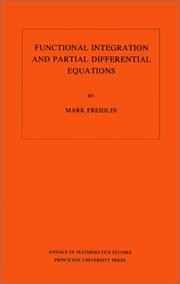
ISBN: 0691083541 1400881595 Year: 1985 Publisher: Princeton, N.J.
Abstract | Keywords | Export | Availability | Bookmark
 Loading...
Loading...Choose an application
- Reference Manager
- EndNote
- RefWorks (Direct export to RefWorks)
This book discusses some aspects of the theory of partial differential equations from the viewpoint of probability theory. It is intended not only for specialists in partial differential equations or probability theory but also for specialists in asymptotic methods and in functional analysis. It is also of interest to physicists who use functional integrals in their research. The work contains results that have not previously appeared in book form, including research contributions of the author.
Partial differential equations --- Differential equations, Partial. --- Probabilities. --- Integration, Functional. --- Functional integration --- Functional analysis --- Integrals, Generalized --- Probability --- Statistical inference --- Combinations --- Mathematics --- Chance --- Least squares --- Mathematical statistics --- Risk --- A priori estimate. --- Absolute continuity. --- Almost surely. --- Analytic continuation. --- Axiom. --- Big O notation. --- Boundary (topology). --- Boundary value problem. --- Bounded function. --- Calculation. --- Cauchy problem. --- Central limit theorem. --- Characteristic function (probability theory). --- Chebyshev's inequality. --- Coefficient. --- Comparison theorem. --- Continuous function (set theory). --- Continuous function. --- Convergence of random variables. --- Cylinder set. --- Degeneracy (mathematics). --- Derivative. --- Differential equation. --- Differential operator. --- Diffusion equation. --- Diffusion process. --- Dimension (vector space). --- Direct method in the calculus of variations. --- Dirichlet boundary condition. --- Dirichlet problem. --- Eigenfunction. --- Eigenvalues and eigenvectors. --- Elliptic operator. --- Elliptic partial differential equation. --- Equation. --- Existence theorem. --- Exponential function. --- Feynman–Kac formula. --- Fokker–Planck equation. --- Function space. --- Functional analysis. --- Fundamental solution. --- Gaussian measure. --- Girsanov theorem. --- Hessian matrix. --- Hölder condition. --- Independence (probability theory). --- Integral curve. --- Integral equation. --- Invariant measure. --- Iterated logarithm. --- Itô's lemma. --- Joint probability distribution. --- Laplace operator. --- Laplace's equation. --- Lebesgue measure. --- Limit (mathematics). --- Limit cycle. --- Limit point. --- Linear differential equation. --- Linear map. --- Lipschitz continuity. --- Markov chain. --- Markov process. --- Markov property. --- Maximum principle. --- Mean value theorem. --- Measure (mathematics). --- Modulus of continuity. --- Moment (mathematics). --- Monotonic function. --- Navier–Stokes equations. --- Nonlinear system. --- Ordinary differential equation. --- Parameter. --- Partial differential equation. --- Periodic function. --- Poisson kernel. --- Probabilistic method. --- Probability space. --- Probability theory. --- Probability. --- Random function. --- Regularization (mathematics). --- Schrödinger equation. --- Self-adjoint operator. --- Sign (mathematics). --- Simultaneous equations. --- Smoothness. --- State-space representation. --- Stochastic calculus. --- Stochastic differential equation. --- Stochastic. --- Support (mathematics). --- Theorem. --- Theory. --- Uniqueness theorem. --- Variable (mathematics). --- Weak convergence (Hilbert space). --- Wiener process.
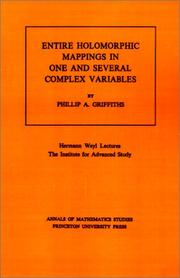
ISBN: 0691081719 0691081727 140088148X 9780691081724 9780691081717 Year: 1976 Volume: no. 85 Publisher: Princeton (N.J.): Princeton university press,
Abstract | Keywords | Export | Availability | Bookmark
 Loading...
Loading...Choose an application
- Reference Manager
- EndNote
- RefWorks (Direct export to RefWorks)
The present monograph grew out of the fifth set of Hermann Weyl Lectures, given by Professor Griffiths at the Institute for Advanced Study, Princeton, in fall 1974.In Chapter 1 the author discusses Emile Borel's proof and the classical Jensen theorem, order of growth of entire analytic sets, order functions for entire holomorphic mappings, classical indicators of orders of growth, and entire functions and varieties of finite order.Chapter 2 is devoted to the appearance of curvature, and Chapter 3 considers the defect relations. The author considers the lemma on the logarithmic derivative, R. Nevanlinna's proof of the defect relation, and refinements of the classical case.
Complex analysis --- Holomorphic mappings --- Applications holomorphes --- 517.53 --- Mappings, Holomorphic --- Functions of several complex variables --- Mappings (Mathematics) --- Functions of a complex variable --- Holomorphic mappings. --- 517.53 Functions of a complex variable --- Fonctions de plusieurs variables complexes --- Fonctions entières --- Functions, Entire --- Algebraic variety. --- Analytic function. --- Analytic set. --- Armand Borel. --- Big O notation. --- Canonical bundle. --- Cartesian coordinate system. --- Characteristic function (probability theory). --- Characterization (mathematics). --- Chern class. --- Compact Riemann surface. --- Compact space. --- Complex analysis. --- Complex manifold. --- Complex projective space. --- Corollary. --- Counting. --- Curvature. --- Degeneracy (mathematics). --- Derivative. --- Differential form. --- Dimension. --- Divisor. --- Elementary proof. --- Entire function. --- Equation. --- Exponential growth. --- Gaussian curvature. --- Hermann Weyl. --- Hodge theory. --- Holomorphic function. --- Hyperplane. --- Hypersurface. --- Infinite product. --- Integral geometry. --- Invariant measure. --- Inverse problem. --- Jacobian matrix and determinant. --- Kähler manifold. --- Line bundle. --- Linear equation. --- Logarithmic derivative. --- Manifold. --- Meromorphic function. --- Modular form. --- Monograph. --- Nevanlinna theory. --- Nonlinear system. --- Phillip Griffiths. --- Picard theorem. --- Polynomial. --- Projective space. --- Q.E.D. --- Quantity. --- Ricci curvature. --- Riemann sphere. --- Scientific notation. --- Several complex variables. --- Special case. --- Stokes' theorem. --- Subset. --- Summation. --- Theorem. --- Theory. --- Uniformization theorem. --- Unit square. --- Volume form. --- Fonctions entières
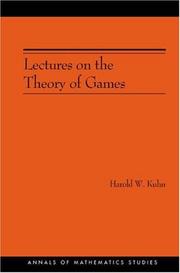
ISBN: 0691027714 0691027722 9786612159114 1282159119 1400829569 9781400829569 9781282159112 6612159111 9780691027715 9780691027722 Year: 2003 Volume: 37 Publisher: Princeton, N.J. : Princeton University Press,
Abstract | Keywords | Export | Availability | Bookmark
 Loading...
Loading...Choose an application
- Reference Manager
- EndNote
- RefWorks (Direct export to RefWorks)
This book is a spectacular introduction to the modern mathematical discipline known as the Theory of Games. Harold Kuhn first presented these lectures at Princeton University in 1952. They succinctly convey the essence of the theory, in part through the prism of the most exciting developments at its frontiers half a century ago. Kuhn devotes considerable space to topics that, while not strictly the subject matter of game theory, are firmly bound to it. These are taken mainly from the geometry of convex sets and the theory of probability distributions. The book opens by addressing "matrix games," a name first introduced in these lectures as an abbreviation for two-person, zero-sum games in normal form with a finite number of pure strategies. It continues with a treatment of games in extensive form, using a model introduced by the author in 1950 that quickly supplanted von Neumann and Morgenstern's cumbersome approach. A final section deals with games that have an infinite number of pure strategies for the two players. Throughout, the theory is generously illustrated with examples, and exercises test the reader's understanding. A historical note caps off each chapter. For readers familiar with the calculus and with elementary matrix theory or vector analysis, this book offers an indispensable store of vital insights on a subject whose importance has only grown with the years.
Operational research. Game theory --- Game theory --- 519.83 --- Theory of games --- 519.83 Theory of games --- Game theory. --- Games, Theory of --- Mathematical models --- Mathematics --- Abstract algebra. --- Addition. --- Algorithm. --- Almost surely. --- Analytic geometry. --- Axiom. --- Basic solution (linear programming). --- Big O notation. --- Bijection. --- Binary relation. --- Boundary (topology). --- Bounded set (topological vector space). --- Branch point. --- Calculation. --- Cardinality of the continuum. --- Cardinality. --- Cartesian coordinate system. --- Characteristic function (probability theory). --- Combination. --- Computation. --- Connectivity (graph theory). --- Constructive proof. --- Convex combination. --- Convex function. --- Convex hull. --- Convex set. --- Coordinate system. --- David Gale. --- Diagram (category theory). --- Differential equation. --- Dimension (vector space). --- Dimensional analysis. --- Disjoint sets. --- Distribution function. --- Embedding. --- Empty set. --- Enumeration. --- Equation. --- Equilibrium point. --- Equivalence relation. --- Estimation. --- Euclidean space. --- Existential quantification. --- Expected loss. --- Extreme point. --- Formal scheme. --- Fundamental theorem. --- Galois theory. --- Geometry. --- Hyperplane. --- Inequality (mathematics). --- Infimum and supremum. --- Integer. --- Iterative method. --- Line segment. --- Linear equation. --- Linear inequality. --- Matching Pennies. --- Mathematical induction. --- Mathematical optimization. --- Mathematical theory. --- Mathematician. --- Mathematics. --- Matrix (mathematics). --- Measure (mathematics). --- Min-max theorem. --- Minimum distance. --- Mutual exclusivity. --- Prediction. --- Probability distribution. --- Probability interpretations. --- Probability measure. --- Probability theory. --- Probability. --- Proof by contradiction. --- Quantity. --- Rank (linear algebra). --- Rational number. --- Real number. --- Requirement. --- Scientific notation. --- Sign (mathematics). --- Solution set. --- Special case. --- Statistics. --- Strategist. --- Strategy (game theory). --- Subset. --- Theorem. --- Theory of Games and Economic Behavior. --- Theory. --- Three-dimensional space (mathematics). --- Total order. --- Two-dimensional space. --- Union (set theory). --- Unit interval. --- Unit square. --- Vector Analysis. --- Vector calculus. --- Vector space.
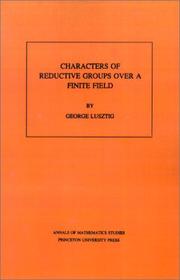
ISBN: 0691083509 0691083517 1400881773 9780691083513 9780691083506 Year: 1984 Volume: 107 Publisher: Princeton (N.J.): Princeton university press,
Abstract | Keywords | Export | Availability | Bookmark
 Loading...
Loading...Choose an application
- Reference Manager
- EndNote
- RefWorks (Direct export to RefWorks)
This book presents a classification of all (complex)irreducible representations of a reductive group withconnected centre, over a finite field. To achieve this,the author uses etale intersection cohomology, anddetailed information on representations of Weylgroups.
512 --- Characters of groups --- Finite fields (Algebra) --- Finite groups --- Groups, Finite --- Group theory --- Modules (Algebra) --- Modular fields (Algebra) --- Algebra, Abstract --- Algebraic fields --- Galois theory --- Characters, Group --- Group characters --- Groups, Characters of --- Representations of groups --- Rings (Algebra) --- Algebra --- 512 Algebra --- Finite groups. --- Characters of groups. --- Addition. --- Algebra representation. --- Algebraic closure. --- Algebraic group. --- Algebraic variety. --- Algebraically closed field. --- Bijection. --- Borel subgroup. --- Cartan subalgebra. --- Character table. --- Character theory. --- Characteristic function (probability theory). --- Characteristic polynomial. --- Class function (algebra). --- Classical group. --- Coefficient. --- Cohomology with compact support. --- Cohomology. --- Combination. --- Complex number. --- Computation. --- Conjugacy class. --- Connected component (graph theory). --- Coxeter group. --- Cyclic group. --- Cyclotomic polynomial. --- David Kazhdan. --- Dense set. --- Derived category. --- Diagram (category theory). --- Dimension. --- Direct sum. --- Disjoint sets. --- Disjoint union. --- E6 (mathematics). --- Eigenvalues and eigenvectors. --- Endomorphism. --- Equivalence class. --- Equivalence relation. --- Existential quantification. --- Explicit formula. --- Explicit formulae (L-function). --- Fiber bundle. --- Finite field. --- Finite group. --- Fourier transform. --- Green's function. --- Group (mathematics). --- Group action. --- Group representation. --- Harish-Chandra. --- Hecke algebra. --- Identity element. --- Integer. --- Irreducible representation. --- Isomorphism class. --- Jordan decomposition. --- Line bundle. --- Linear combination. --- Local system. --- Mathematical induction. --- Maximal torus. --- Module (mathematics). --- Monodromy. --- Morphism. --- Orthonormal basis. --- P-adic number. --- Parametrization. --- Parity (mathematics). --- Partially ordered set. --- Perverse sheaf. --- Pointwise. --- Polynomial. --- Quantity. --- Rational point. --- Reductive group. --- Ree group. --- Schubert variety. --- Scientific notation. --- Semisimple Lie algebra. --- Sheaf (mathematics). --- Simple group. --- Simple module. --- Special case. --- Standard basis. --- Subset. --- Subtraction. --- Summation. --- Surjective function. --- Symmetric group. --- Tensor product. --- Theorem. --- Two-dimensional space. --- Unipotent representation. --- Vector bundle. --- Vector space. --- Verma module. --- Weil conjecture. --- Weyl group. --- Zariski topology.
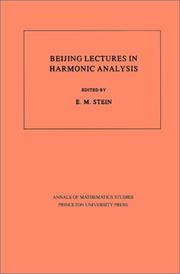
ISBN: 0691084181 069108419X 1400882095 Year: 1986 Publisher: Princeton (N.J.) Princeton University Press
Abstract | Keywords | Export | Availability | Bookmark
 Loading...
Loading...Choose an application
- Reference Manager
- EndNote
- RefWorks (Direct export to RefWorks)
Based on seven lecture series given by leading experts at a summer school at Peking University, in Beijing, in 1984. this book surveys recent developments in the areas of harmonic analysis most closely related to the theory of singular integrals, real-variable methods, and applications to several complex variables and partial differential equations. The different lecture series are closely interrelated; each contains a substantial amount of background material, as well as new results not previously published. The contributors to the volume are R. R. Coifman and Yves Meyer, Robert Fcfferman,Carlos K. Kenig, Steven G. Krantz, Alexander Nagel, E. M. Stein, and Stephen Wainger.
Harmonic analysis. --- Analysis (Mathematics) --- Functions, Potential --- Potential functions --- Banach algebras --- Calculus --- Mathematical analysis --- Mathematics --- Bessel functions --- Fourier series --- Harmonic functions --- Time-series analysis --- Analytic function. --- Asymptotic formula. --- Bergman metric. --- Bernhard Riemann. --- Bessel function. --- Biholomorphism. --- Boundary value problem. --- Bounded mean oscillation. --- Bounded operator. --- Boundedness. --- Cauchy's integral formula. --- Characteristic function (probability theory). --- Characterization (mathematics). --- Coefficient. --- Commutator. --- Complexification (Lie group). --- Continuous function. --- Convolution. --- Degeneracy (mathematics). --- Differential equation. --- Differential operator. --- Dirac delta function. --- Dirichlet problem. --- Equation. --- Estimation. --- Existence theorem. --- Existential quantification. --- Explicit formula. --- Explicit formulae (L-function). --- Fatou's theorem. --- Fourier analysis. --- Fourier integral operator. --- Fourier transform. --- Fredholm theory. --- Fubini's theorem. --- Function (mathematics). --- Functional calculus. --- Fundamental solution. --- Gaussian curvature. --- Hardy space. --- Harmonic function. --- Harmonic measure. --- Heisenberg group. --- Hilbert space. --- Hilbert transform. --- Hodge theory. --- Holomorphic function. --- Hyperbolic partial differential equation. --- Hölder's inequality. --- Infimum and supremum. --- Integration by parts. --- Interpolation theorem. --- Intersection (set theory). --- Invertible matrix. --- Isometry group. --- Laplace operator. --- Laplace's equation. --- Lebesgue measure. --- Linear map. --- Lipschitz continuity. --- Lipschitz domain. --- Lp space. --- Mathematical induction. --- Mathematical physics. --- Maximal function. --- Maximum principle. --- Measure (mathematics). --- Newtonian potential. --- Non-Euclidean geometry. --- Number theory. --- Operator theory. --- Oscillatory integral. --- Parameter. --- Partial derivative. --- Partial differential equation. --- Polynomial. --- Power series. --- Product metric. --- Radon–Nikodym theorem. --- Riemannian manifold. --- Riesz representation theorem. --- Scientific notation. --- Several complex variables. --- Sign (mathematics). --- Simultaneous equations. --- Singular function. --- Singular integral. --- Sobolev space. --- Square (algebra). --- Statistical hypothesis testing. --- Stokes' theorem. --- Support (mathematics). --- Tangent space. --- Tensor product. --- Theorem. --- Trigonometric series. --- Uniformization theorem. --- Variable (mathematics). --- Vector field.
Book
ISBN: 0691145423 0691145415 9780691145419 9780691145426 1282645064 9786612645068 1400835402 9781400835409 9781282645066 Year: 2010 Publisher: Princeton : Princeton University Press,
Abstract | Keywords | Export | Availability | Bookmark
 Loading...
Loading...Choose an application
- Reference Manager
- EndNote
- RefWorks (Direct export to RefWorks)
Ramsey theory is a fast-growing area of combinatorics with deep connections to other fields of mathematics such as topological dynamics, ergodic theory, mathematical logic, and algebra. The area of Ramsey theory dealing with Ramsey-type phenomena in higher dimensions is particularly useful. Introduction to Ramsey Spaces presents in a systematic way a method for building higher-dimensional Ramsey spaces from basic one-dimensional principles. It is the first book-length treatment of this area of Ramsey theory, and emphasizes applications for related and surrounding fields of mathematics, such as set theory, combinatorics, real and functional analysis, and topology. In order to facilitate accessibility, the book gives the method in its axiomatic form with examples that cover many important parts of Ramsey theory both finite and infinite. An exciting new direction for combinatorics, this book will interest graduate students and researchers working in mathematical subdisciplines requiring the mastery and practice of high-dimensional Ramsey theory.
Algebraic spaces. --- Ramsey theory. --- Ramsey theory --- Algebraic spaces --- Mathematics --- Algebra --- Physical Sciences & Mathematics --- Spaces, Algebraic --- Geometry, Algebraic --- Combinatorial analysis --- Graph theory --- Analytic set. --- Axiom of choice. --- Baire category theorem. --- Baire space. --- Banach space. --- Bijection. --- Binary relation. --- Boolean prime ideal theorem. --- Borel equivalence relation. --- Borel measure. --- Borel set. --- C0. --- Cantor cube. --- Cantor set. --- Cantor space. --- Cardinality. --- Characteristic function (probability theory). --- Characterization (mathematics). --- Combinatorics. --- Compact space. --- Compactification (mathematics). --- Complete metric space. --- Completely metrizable space. --- Constructible universe. --- Continuous function (set theory). --- Continuous function. --- Corollary. --- Countable set. --- Counterexample. --- Decision problem. --- Dense set. --- Diagonalization. --- Dimension (vector space). --- Dimension. --- Discrete space. --- Disjoint sets. --- Dual space. --- Embedding. --- Equation. --- Equivalence relation. --- Existential quantification. --- Family of sets. --- Forcing (mathematics). --- Forcing (recursion theory). --- Gap theorem. --- Geometry. --- Ideal (ring theory). --- Infinite product. --- Lebesgue measure. --- Limit point. --- Lipschitz continuity. --- Mathematical induction. --- Mathematical problem. --- Mathematics. --- Metric space. --- Metrization theorem. --- Monotonic function. --- Natural number. --- Natural topology. --- Neighbourhood (mathematics). --- Null set. --- Open set. --- Order type. --- Partial function. --- Partially ordered set. --- Peano axioms. --- Point at infinity. --- Pointwise. --- Polish space. --- Probability measure. --- Product measure. --- Product topology. --- Property of Baire. --- Ramsey's theorem. --- Right inverse. --- Scalar multiplication. --- Schauder basis. --- Semigroup. --- Sequence. --- Sequential space. --- Set (mathematics). --- Set theory. --- Sperner family. --- Subsequence. --- Subset. --- Subspace topology. --- Support function. --- Symmetric difference. --- Theorem. --- Topological dynamics. --- Topological group. --- Topological space. --- Topology. --- Tree (data structure). --- Unit interval. --- Unit sphere. --- Variable (mathematics). --- Well-order. --- Zorn's lemma.
Book
ISBN: 0691080747 1322884773 0691621411 0691648077 1400868572 9780691080741 Year: 1970 Publisher: Princeton: Princeton university press,
Abstract | Keywords | Export | Availability | Bookmark
 Loading...
Loading...Choose an application
- Reference Manager
- EndNote
- RefWorks (Direct export to RefWorks)
Encompassing both introductory and more advanced research material, these notes deal with the author's contributions to stochastic processes and focus on Brownian motion processes and its derivative white noise.Originally published in 1970.The Princeton Legacy Library uses the latest print-on-demand technology to again make available previously out-of-print books from the distinguished backlist of Princeton University Press. These editions preserve the original texts of these important books while presenting them in durable paperback and hardcover editions. The goal of the Princeton Legacy Library is to vastly increase access to the rich scholarly heritage found in the thousands of books published by Princeton University Press since its founding in 1905.
Stationary processes --- Stationary processes. --- Stochastic processes --- 519.216 --- 519.216 Stochastic processes in general. Prediction theory. Stopping times. Martingales --- Stochastic processes in general. Prediction theory. Stopping times. Martingales --- Bochner integral. --- Bochner's theorem. --- Bounded operator. --- Bounded variation. --- Brownian motion. --- Characteristic exponent. --- Characteristic function (probability theory). --- Complexification. --- Compound Poisson process. --- Computation. --- Conditional expectation. --- Continuous function (set theory). --- Continuous function. --- Continuous linear operator. --- Convergence of random variables. --- Coset. --- Covariance function. --- Cyclic subspace. --- Cylinder set. --- Degrees of freedom (statistics). --- Derivative. --- Differential equation. --- Dimension (vector space). --- Dirac delta function. --- Discrete spectrum. --- Distribution function. --- Dual space. --- Eigenfunction. --- Equation. --- Existential quantification. --- Exponential distribution. --- Exponential function. --- Finite difference. --- Fourier series. --- Fourier transform. --- Function (mathematics). --- Function space. --- Gaussian measure. --- Gaussian process. --- Harmonic analysis. --- Hermite polynomials. --- Hilbert space. --- Homeomorphism. --- Independence (probability theory). --- Independent and identically distributed random variables. --- Indicator function. --- Infinitesimal generator (stochastic processes). --- Integral equation. --- Isometry. --- Joint probability distribution. --- Langevin equation. --- Lebesgue measure. --- Lie algebra. --- Limit superior and limit inferior. --- Linear combination. --- Linear function. --- Linear interpolation. --- Linear subspace. --- Mean squared error. --- Measure (mathematics). --- Monotonic function. --- Normal distribution. --- Normal subgroup. --- Nuclear space. --- One-parameter group. --- Orthogonality. --- Orthogonalization. --- Parameter. --- Poisson point process. --- Polynomial. --- Probability distribution. --- Probability measure. --- Probability space. --- Probability. --- Projective linear group. --- Radon–Nikodym theorem. --- Random function. --- Random variable. --- Reproducing kernel Hilbert space. --- Self-adjoint operator. --- Self-adjoint. --- Semigroup. --- Shift operator. --- Special case. --- Stable process. --- Stationary process. --- Stochastic differential equation. --- Stochastic process. --- Stochastic. --- Subgroup. --- Summation. --- Symmetrization. --- Theorem. --- Transformation semigroup. --- Unitary operator. --- Unitary representation. --- Unitary transformation. --- Variance. --- White noise. --- Zero element.

ISBN: 0691005478 0691080046 1400883865 9780691080048 9780691005478 Year: 1974 Volume: 9 Publisher: Princeton (N.J.): Princeton university press,
Abstract | Keywords | Export | Availability | Bookmark
 Loading...
Loading...Choose an application
- Reference Manager
- EndNote
- RefWorks (Direct export to RefWorks)
In this classic of statistical mathematical theory, Harald Cramér joins the two major lines of development in the field: while British and American statisticians were developing the science of statistical inference, French and Russian probabilitists transformed the classical calculus of probability into a rigorous and pure mathematical theory. The result of Cramér's work is a masterly exposition of the mathematical methods of modern statistics that set the standard that others have since sought to follow. For anyone with a working knowledge of undergraduate mathematics the book is self contained. The first part is an introduction to the fundamental concept of a distribution and of integration with respect to a distribution. The second part contains the general theory of random variables and probability distributions while the third is devoted to the theory of sampling, statistical estimation, and tests of significance.
Mathematical statistics --- 519.2 --- 519.2 Probability. Mathematical statistics --- Probability. Mathematical statistics --- Mathematics --- Statistical inference --- Statistics, Mathematical --- Statistics --- Probabilities --- Sampling (Statistics) --- Statistical methods --- Statistique mathématique --- Mathematical statistics. --- Statistique mathématique --- Statistique mathématique. --- Distribution (théorie des probabilités) --- Distribution (Probability theory) --- A priori probability. --- Addition theorem. --- Additive function. --- Analysis of covariance. --- Arithmetic mean. --- Axiom. --- Bayes' theorem. --- Bias of an estimator. --- Binomial distribution. --- Binomial theorem. --- Bolzano–Weierstrass theorem. --- Borel set. --- Bounded set (topological vector space). --- Calculation. --- Cartesian product. --- Central moment. --- Characteristic function (probability theory). --- Characteristic polynomial. --- Coefficient. --- Commutative property. --- Confidence interval. --- Convergence of random variables. --- Correlation coefficient. --- Degeneracy (mathematics). --- Degrees of freedom (statistics). --- Diagram (category theory). --- Dimension. --- Distribution (mathematics). --- Distribution function. --- Empirical distribution function. --- Equation. --- Estimation theory. --- Estimation. --- Identity matrix. --- Independence (probability theory). --- Interval (mathematics). --- Inverse probability. --- Invertible matrix. --- Joint probability distribution. --- Laplace distribution. --- Lebesgue integration. --- Lebesgue measure. --- Lebesgue–Stieltjes integration. --- Likelihood function. --- Limit (mathematics). --- Linear regression. --- Logarithm. --- Logarithmic derivative. --- Logarithmic scale. --- Marginal distribution. --- Mathematical analysis. --- Mathematical induction. --- Mathematical theory. --- Mathematics. --- Matrix (mathematics). --- Maxima and minima. --- Measure (mathematics). --- Method of moments (statistics). --- Metric space. --- Minor (linear algebra). --- Moment (mathematics). --- Moment matrix. --- Normal distribution. --- Numerical analysis. --- Parameter. --- Parity (mathematics). --- Poisson distribution. --- Probability distribution. --- Probability theory. --- Probability. --- Proportionality (mathematics). --- Quantity. --- Random variable. --- Realization (probability). --- Riemann integral. --- Sample space. --- Sampling (statistics). --- Scientific notation. --- Series (mathematics). --- Set (mathematics). --- Set function. --- Sign (mathematics). --- Standard deviation. --- Statistic. --- Statistical Science. --- Statistical hypothesis testing. --- Statistical inference. --- Statistical regularity. --- Statistical theory. --- Subset. --- Summation. --- Theorem. --- Theory. --- Transfinite number. --- Uniform distribution (discrete). --- Variable (mathematics). --- Variance. --- Weighted arithmetic mean. --- Z-test. --- Distribution (théorie des probabilités)
Book
ISBN: 0691081093 9781400871261 1400871263 9780691620114 9780691081090 0691620113 9780691081090 0691646945 9780691646947 Year: 1972 Volume: 11 Publisher: Princeton: Princeton university press,
Abstract | Keywords | Export | Availability | Bookmark
 Loading...
Loading...Choose an application
- Reference Manager
- EndNote
- RefWorks (Direct export to RefWorks)
This book has as its subject the boundary value theory of holomorphic functions in several complex variables, a topic that is just now coming to the forefront of mathematical analysis. For one variable, the topic is classical and rather well understood. In several variables, the necessary understanding of holomorphic functions via partial differential equations has a recent origin, and Professor Stein's book, which emphasizes the potential-theoretic aspects of the boundary value problem, should become the standard work in the field.Originally published in 1972.The Princeton Legacy Library uses the latest print-on-demand technology to again make available previously out-of-print books from the distinguished backlist of Princeton University Press. These editions preserve the original texts of these important books while presenting them in durable paperback and hardcover editions. The goal of the Princeton Legacy Library is to vastly increase access to the rich scholarly heritage found in the thousands of books published by Princeton University Press since its founding in 1905.
Mathematical potential theory --- Holomorphic functions --- Harmonic functions --- Holomorphic functions. --- Harmonic functions. --- Fonctions de plusieurs variables complexes. --- Functions of several complex variables --- Functions, Harmonic --- Laplace's equations --- Bessel functions --- Differential equations, Partial --- Fourier series --- Harmonic analysis --- Lamé's functions --- Spherical harmonics --- Toroidal harmonics --- Functions, Holomorphic --- Absolute continuity. --- Absolute value. --- Addition. --- Ambient space. --- Analytic function. --- Arbitrarily large. --- Bergman metric. --- Borel measure. --- Boundary (topology). --- Boundary value problem. --- Bounded set (topological vector space). --- Boundedness. --- Brownian motion. --- Calculation. --- Change of variables. --- Characteristic function (probability theory). --- Combination. --- Compact space. --- Complex analysis. --- Complex conjugate. --- Computation. --- Conformal map. --- Constant term. --- Continuous function. --- Coordinate system. --- Corollary. --- Cramer's rule. --- Determinant. --- Diameter. --- Dimension. --- Elliptic operator. --- Estimation. --- Existential quantification. --- Explicit formulae (L-function). --- Exterior (topology). --- Fatou's theorem. --- Function space. --- Green's function. --- Green's theorem. --- Haar measure. --- Half-space (geometry). --- Harmonic function. --- Hilbert space. --- Holomorphic function. --- Hyperbolic space. --- Hypersurface. --- Hölder's inequality. --- Invariant measure. --- Invertible matrix. --- Jacobian matrix and determinant. --- Line segment. --- Linear map. --- Lipschitz continuity. --- Local coordinates. --- Logarithm. --- Majorization. --- Matrix (mathematics). --- Maximal function. --- Measure (mathematics). --- Minimum distance. --- Natural number. --- Normal (geometry). --- Open set. --- Order of magnitude. --- Orthogonal complement. --- Orthonormal basis. --- Parameter. --- Poisson kernel. --- Positive-definite matrix. --- Potential theory. --- Projection (linear algebra). --- Quadratic form. --- Quantity. --- Real structure. --- Requirement. --- Scientific notation. --- Sesquilinear form. --- Several complex variables. --- Sign (mathematics). --- Smoothness. --- Subgroup. --- Subharmonic function. --- Subsequence. --- Subset. --- Summation. --- Tangent space. --- Theorem. --- Theory. --- Total variation. --- Transitive relation. --- Transitivity. --- Transpose. --- Two-form. --- Unit sphere. --- Unitary matrix. --- Vector field. --- Vector space. --- Volume element. --- Weak topology.
| Listing 1 - 10 of 17 | << page >> |
Sort by
|

 Search
Search Feedback
Feedback About UniCat
About UniCat  Help
Help News
News